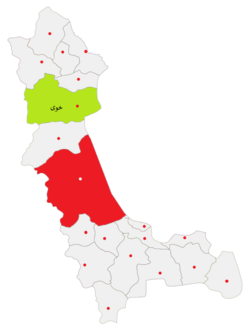Khoy County
|
Khoy County شهرستان خوی |
|
|---|---|
| County | |
 Location of Khoy County in West Azerbaijan Province. |
|
| Country |
|
| Province | West Azerbaijan |
| Capital | Khoy |
| Bakhsh (Districts) | Central District |
| Population (2006) | |
| • Total | 323,348 |
| Time zone | IRST (UTC+3:30) |
| • Summer (DST) | IRDT (UTC+4:30) |
Khoy County (Persian: شهرستان خوی) is a county in West Azerbaijan Province in Iran. At the 2006 census, the county's population (including those portions later split off to form Chaypareh County was 365,573, in 85,550 families; excluding those portions, the population was 323,348, in 75,464 families. The capital of the county is Khoy.
Khoy was named in ancient times for the salt mines that made it an important spur of the Silk Route. 3000 years ago, a city had existed on the area where Khoy is located nowadays, but its name became Khoy only from 14 centuries ago. In 714 BC, Sargon II passed the region of which Khoy is part of in a campaign against Urartu.
In the Parthian period, Khoy was the gateway of the Parthian Empire in the Northwest. Around 37 BC, Marc Anthony had crossed the plain that is located between Khoy and Marand during one of the many and frequent Roman-Parthian Wars.
One of the important historic elements of the city's Khoy in the county is the St. Sourp Sarkis church, one of the many churches in the county. Armenian documents wrote that the date of the making has to be either 332 or 333 AD. In the city of Khoy and its surrounding villages, churches are seen and it is reported that Armenians have always been comprising a significant amount of the city's population, but the city was never an "Armenian city" (as in comprising a vast majority).
Khoy city was fortified at various times in its history, most recently by the Qajar dynasty in the nineteenth century.
After the death of Nadir Shah Afshar in 1747, Khoy and its immediate surroundings broke away from central government of Iran like several other regions of Iran, including what is now Georgia and some of the northern Caucasian Khanates comprising the northwestern territories of Iran. Khoy became the centre of the newly established Khanate of Khoy (1747–1813) which was loyal to the central government only when it was powerful (like during Karim Khan's reign), and autonomous when the central role was weak. The return of Khoy to the central government of Iran was during the beginning of Qajar period during Agha Mohammad Khan's reign. Khoy was attacked in 1827 by Russia who was attempting to seize the last of the Caucasian territories of Iran comprising Armenia and what is now Azerbaijan during the Russo-Persian War (1826–1828). The war, which mainly razed in the extremely nearby South Caucasus region eventually happened to moved deeper south as well. Until 1828, Khoy had a large number of Armenians, however, the Treaty of Turkmenchay following the outcome of the 1826–1828 war and the victory over the neighbouring Ottoman Empire as concluded in the Treaty of Adrianople, encouraged the mass resettlement of Armenians from both Turkey and Iran in Russia. In the mid-1800s some of them immigrated to eastern Armenia, which by then had just became part of the Russian Empire. However, a small Armenian population remains living in Khoy city and county. Eli Smith notes in his "Missionary Researches in Armenia: Including a Journey through Asia Minor, an into Georgia and Persia" released in 1834 that he and his group had heard whirl passing through Khoy that the city had between 4000 and 7000 Muslim families, while only about 100 Armenian families were left. He noted further that in the immediate villages around Khoy city there were a few more, but the vast majority had migrated to the North of the Aras river following Russia's victory over Persia in 1828 and the encouraged settling in the newly incorporated Russian regions of Eastern Armenia.
...
Wikipedia
